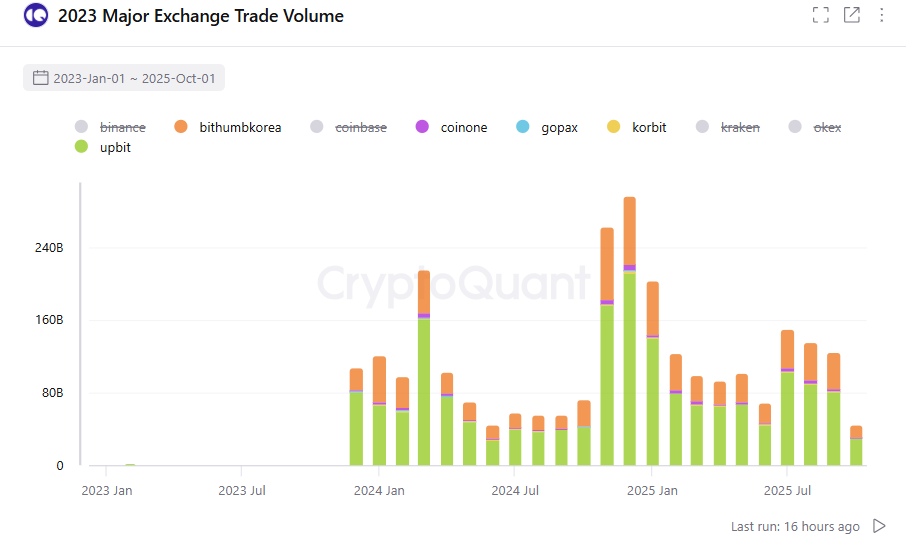South Korean crypto trading activity has declined to a one-year low, with traders shifting to the stock market for more stable returns amid inflation concerns and a lack of altcoin momentum. This exodus highlights a broader preference for reliable assets like the surging KOSPI index.
-
South Korean exchanges see lowest volumes in a year due to user outflow.
-
Traders favor stocks over crypto for consistent gains amid economic pressures.
-
KOSPI index hits all-time high, up 19.94% in October, driven by tech giants like Samsung Electronics with 85% yearly returns.
South Korean crypto trading decline pushes investors to stocks amid KOSPI surge. Explore why altcoins lost appeal and how inflation shifted focus—discover reliable investment strategies today.
What is causing the South Korean crypto trading decline?
South Korean crypto trading decline stems from traders seeking more reliable returns in the stock market, as crypto volumes hit a one-year low on local exchanges. Ki Young Ju, founder of CryptoQuant, highlighted that activity on these platforms has slumped significantly. This shift follows a period where altcoins briefly revived on South Korean markets, but unsustainable pumps led to user outflows, exacerbated by inflation and bear market fears.
Interest in crypto trading in South Korea has notably waned, with many participants redirecting their capital toward the stock market in pursuit of steadier gains. South Korean crypto markets have experienced a marked slowdown, as traders pivot back to equities amid broader economic uncertainties.
 Trading volumes on South Korean exchanges diminished, due to the lack of an altcoin season, while investor attention shifted to stocks and stock indexes. | Source: CryptoQuant.
Trading volumes on South Korean exchanges diminished, due to the lack of an altcoin season, while investor attention shifted to stocks and stock indexes. | Source: CryptoQuant.Until recently, South Korean exchanges played a key role in providing liquidity and generating hype for older altcoins, often listing them long after they had faded from global attention. These platforms adopted a conservative approach to altcoin selections, which sometimes led to temporary revivals but failed to foster lasting market sustainability. As a result, user outflows intensified, with overall crypto exchange volumes reaching their lowest levels in the past year.
The broader crypto landscape has also evolved, with traders increasingly favoring global platforms like Binance or decentralized exchanges for perpetual contracts. South Korean exchanges, which primarily serve local retail users through pairs against the South Korean won, have struggled to retain this base. As previously noted in financial reports, another wave of inflation in South Korea has prompted investors to seek hedges against currency devaluation. In past cycles, speculative crypto trading filled this void, but current bear market apprehensions have accelerated the shift away from digital assets.
How are South Korean exchanges maintaining a price premium despite outflows?
South Korean exchanges continue to exhibit a price premium on select assets, even as user activity diminishes. The South Korean Premium Index flipped positive in October, indicating persistent buying interest from remaining local investors. This premium particularly affects Bitcoin, where prices on these platforms trade higher than global averages, signaling confidence among holdouts.
 BTC still held a premium on South Korean exchanges, signaling buying interest. The deeper losses of altcoins made investors give up on crypto trading. | Source: CryptoQuant.
BTC still held a premium on South Korean exchanges, signaling buying interest. The deeper losses of altcoins made investors give up on crypto trading. | Source: CryptoQuant.However, this premium has narrowed over the past two weeks alongside weakening Bitcoin prices globally. Data from CryptoQuant underscores how altcoins have suffered steeper declines, eroding investor enthusiasm and further dampening trading volumes. Platforms like Upbit still serve as primary venues for assets such as Ripple’s XRP, but subdued altcoin performance has broken expectations for broader growth. The rising perception of crypto risks, without clear market catalysts, has prompted many to abandon once-booming tokens like Pudgy Penguins.
Expert analysis from CryptoQuant’s Ki Young Ju emphasizes that the lack of an altcoin season has been pivotal. “South Korean crypto exchanges are seeing activity slump to a one-year low,” Ju stated, pointing to the exodus toward more predictable investments. This trend aligns with global patterns where retail-driven markets face challenges in retaining users during volatile periods. South Korean exchanges’ reliance on local liquidity exacerbates these issues, as economic factors like inflation push capital elsewhere.
In contrast, the stock market in South Korea has absorbed much of this redirected liquidity. The KOSPI index has climbed rapidly since April, approaching its all-time high of 4,121.74 points. After two years of flat performance, the index surged from around 2,400 points, closing at a record on November 3. October alone delivered a 19.94% gain—the largest monthly increase since January 2001—fueled by strong performances in technology and AI-related sectors.
Why is the South Korean stock market outperforming crypto?
The South Korean stock market’s resurgence is led by blue-chip companies, with Samsung Electronics posting an impressive 85% yearly return, far outpacing most cryptocurrencies. This performance is bolstered by the global AI boom, which has elevated stocks tied to semiconductors and electronics. Investors, wary of meme coins and legacy altcoins lacking tangible utility, have increasingly viewed equities as a safer bet during inflationary times.
The KOSPI’s momentum reflects broader economic recovery signals, including export growth in key industries. Financial reports indicate that institutional and retail investors alike are prioritizing assets with proven track records over speculative crypto plays. This shift not only highlights the stock market’s reliability but also underscores the challenges facing South Korean crypto exchanges in regaining traction.
From an E-E-A-T perspective, insights from established analytics firms like CryptoQuant provide credible backing for these observations. Their on-chain data reveals a clear correlation between declining crypto volumes and rising stock indices, demonstrating the interconnected nature of local investment flows. Industry experts, including those from major financial institutions, note that without renewed altcoin catalysts, the crypto sector in South Korea may continue to lag.
Frequently Asked Questions
What factors are driving the South Korean crypto trading decline in 2025?
The South Korean crypto trading decline in 2025 is driven by inflation concerns, bear market fears, and a lack of altcoin momentum, leading traders to stocks for stable returns. Volumes on local exchanges hit a one-year low, as reported by CryptoQuant, with users outflowing to more reliable assets like the KOSPI index.
Is the KOSPI index a better investment than crypto for South Korean traders right now?
Yes, the KOSPI index has become a more attractive option for South Korean traders currently, surging to an all-time high with a 19.94% October gain and strong performances from companies like Samsung. This stability contrasts with crypto’s volatility and declining volumes, offering a hedge against inflation in natural, straightforward terms.
Key Takeaways
- South Korean crypto volumes at one-year low: Traders’ shift to stocks reflects a search for reliability amid economic pressures.
- Persistent BTC premium on local exchanges: Remaining investors show buying interest, though altcoins lag severely.
- KOSPI’s record surge signals opportunity: With 85% returns from top stocks, focus on equities provides actionable insights for diversified portfolios.
Conclusion
The South Korean crypto trading decline underscores a pivotal shift toward the stock market, where the KOSPI index’s all-time highs and robust gains from leaders like Samsung Electronics offer more dependable returns. As inflation persists and altcoin seasons remain elusive, investors are prioritizing stability over speculation. Looking ahead, monitoring economic indicators and premium indices will be key—consider reallocating to proven assets for long-term resilience in your portfolio.






